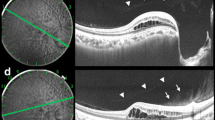Abstract
This photo essay is aimed at showing slit-lamp photographic views and its ultrasound biomicroscopy (UBM) corollaries of angle deposits in pseudoexfoliation syndrome cases and contributes visual arguments to the hypotheses and explanations of the genesis of ocular hypertension.
Similar content being viewed by others
Avoid common mistakes on your manuscript.
Case report
Pseudoexfoliation (PEX) was first described in 1917 by Lindberg [1]. One of the consequences of PEX is ocular hypertension and glaucoma [2], which becomes increasingly frequent with age [3]. Blockage of the trabecular meshwork by the PEX material decreases aqueous humour outflow and increases consequently ocular tension [4]. Jacobi introduced a technique called trabecular aspiration to treat PEX glaucoma [5].
For several years, we have followed patients and correlated slit-lamp photography with ultrasound biomicroscopy (UBM) images of PEX deposits in the iridocorneal angle (ICA). The many images obtained and the sequential analysis of PEX deposits in the angle before and after cataract surgery inspired this photo essay and could represent evidence on the events that can lead to ocular hypertension.
We show a case of an 81-year-old woman followed in our centre for PEX syndrome of the left eye with abundant PEX material on the pupillary border (Fig. 1a) and in the ICA (Fig. 2a) as well as a cataract. Ocular tension was elevated to 24 mmHg despite antihypertensive drops. Exploration of the ICA, especially its lower 180°, was done by UBM (Fig. 3a). Standard cataract surgery with the intraocular lens implantation in the capsular bag was carried out without complications. Special care was given to a thorough washout of PEX material on 360° in the ICA, especially its bottom part. Postoperatively ocular pressure decreased to 11 mmHg on the first postoperative day and remained within the norm during a 1-year of follow-up without any treatment.
Two, 6, and 9 months after cataract surgery, we carried out slit-lamp photography of the same structures showing the absence of PEX material on the pupillary border, surface of the iris (Fig. 1b), and in the ICA (Fig. 2a, b). UBM after cataract surgery also showed that PEX material disappeared in the ICA (Fig. 3b).
Comment
In this case, abundant PEX material on the pupillary margin overflowed onto the iris surface and sedimented to the bottom of the ICA. UBM examination confirmed the presence of PEX material in the bottom of the ICA but not in its upper part. Localization of PEX material in many places in the anterior chamber indicates the large amount of material that can be generated and this material finally gets into the lower part of the ICA.
It is probably this mechanical accumulation of PEX material within the ICA, very clearly demonstrated in this case by slit-lamp photography and UBM, that produces the rise of intraocular pressure. This mechanical thesis seems to be in most cases the sole reason for the increase of pressure, as mechanical washout of the PEX material during cataract surgery seems to solve the problem.
References:
Lindberg JG (1917) Clinical studies of depigmentation of the pupillary margin and transillumination of the iris in cases of senile cataract and also in normal eyes in the aged (Thesis). Helsinki University, Helsinki, Finland; Kliniska undersokningar over depigmenteringen av pupillarranden och genomlysbarheten av iris vid fall av aldersstarr samt i normala ogon hos gamla personer
Ritch R (1994) Exfoliation syndrome: The most common identifiable cause of open-angle glaucoma. Trans Am Ophthalmol Soc 92:845–944
Mitchell P, Wang JJ, Hourihan F (1999) The relationship between glaucoma and pseudoexfoliation: the Blue Mountains eye study. Arch Ophthalmol 117(10):1319–1324
Haydon PR (1986) Pseudoexfoliation syndrome as a cause of chronic glaucoma. Klin Monatsbl Augenheilkd 189:293–301
Jacobi PC, Dietlein TS, Krieglstein GK (1998) Bimanual trabecular aspiration in pseudoexfoliation glaucoma: an alternative in nonfiltering glaucoma surgery. Ophthalmology 105(5):886–894
Open Access
This article is distributed under the terms of the Creative Commons Attribution Noncommercial License which permits any noncommercial use, distribution, and reproduction in any medium, provided the original author(s) and source are credited.
Author information
Authors and Affiliations
Corresponding author
Rights and permissions
Open Access This is an open access article distributed under the terms of the Creative Commons Attribution Noncommercial License (https://creativecommons.org/licenses/by-nc/2.0), which permits any noncommercial use, distribution, and reproduction in any medium, provided the original author(s) and source are credited.
About this article
Cite this article
Tao Tran, V. UBM/slit-lamp-photo imaging of pseudoexfoliation deposits in the iridocorneal angle: imaging clues to the genesis of ocular hypertension. Int Ophthalmol 29, 389–392 (2009). https://doi.org/10.1007/s10792-008-9254-y
Received:
Accepted:
Published:
Issue Date:
DOI: https://doi.org/10.1007/s10792-008-9254-y







